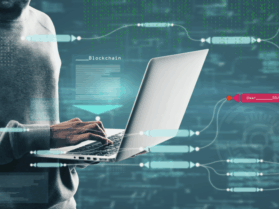The way technological advancements are happening in the world it is no surprise that the field of cybersecurity is growing. Companies are always on the lookout for new and improved solutions for cyberthreats. Cybersecurity cannot depend solely upon human intervention now. Companies need to harness the power of AI in cybersecurity to defend and automate real-time cyberattacks.
Let’s check out the transformative role of AI in cybersecurity, our future predictions, and the innovative solutions it offers.
The Evolution of AI in Cybersecurity
The application of AI in cybersecurity has significantly evolved over the past decade. Initially, cybersecurity measures relied heavily on rule-based systems and human intervention. These traditional methods often fall short in identifying and combating advanced cyber threats. However, the advent of AI has introduced a paradigm shift.
AI-powered systems can analyze vast amounts of data in real-time, identifying patterns and anomalies that could signify potential threats. Machine learning algorithms, a subset of AI, learn from historical data and continuously improve their threat detection capabilities. This dynamic approach enables organizations to stay ahead of cybercriminals, whose tactics are constantly evolving.
Predictive Capabilities of AI and How Can We Harness the Power of AI in Cybersecurity?
One of the most significant advantages of AI in cybersecurity is its predictive capabilities. AI systems can forecast potential cyber-attacks by analyzing historical data and identifying patterns that precede such events. For instance, AI can detect unusual login attempts, data transfers, or network traffic that may indicate a forthcoming breach.
Predictive analytics enable organizations to take proactive measures, such as patching vulnerabilities and reinforcing security protocols before an attack occurs. This not only minimizes the risk of data breaches but also reduces the potential damage and associated costs.
AI-Driven Solutions for Cybersecurity
Cybersecurity AI offers a range of innovative solutions designed to enhance protection and response strategies. Here are some key AI-driven solutions making waves in the cybersecurity landscape:
1. Threat Detection and Response
AI systems excel in threat detection and response by continuously monitoring network traffic, user behavior, and system activities. These systems can identify and respond to threats in real-time, significantly reducing the time it takes to mitigate potential risks. Automated response mechanisms can isolate infected systems, block malicious IP addresses, and neutralize threats without human intervention.
2. Fraud Detection
AI algorithms are highly effective in detecting fraudulent activities. By analyzing transaction patterns, user behavior, and historical data, AI can identify anomalies that may indicate fraud. This is particularly valuable in sectors like finance and e-commerce, where fraudulent activities can lead to significant financial losses.
3. Behavioral Analytics
Behavioral analytics is another powerful application of AI in cybersecurity. AI systems analyze user behavior to establish a baseline of normal activities. Any deviation from this baseline, such as unusual login times or access to sensitive data, triggers an alert. This approach helps in identifying insider threats and compromised accounts, enhancing overall security.
Future Predictions for AI in Cybersecurity
The future of AI in cybersecurity looks promising, with several advancements on the horizon. Here are a few predictions:
1. Increased Automation
AI will drive greater automation in cybersecurity, reducing the reliance on human intervention. Automated systems will handle routine security tasks, allowing cybersecurity professionals to focus on more complex challenges.
2. Advanced Threat Intelligence
AI will enhance threat intelligence by providing more accurate and timely information about emerging threats. This will enable organizations to stay ahead of cybercriminals and deploy effective countermeasures.
3. Improved User Authentication
AI will revolutionize user authentication methods by incorporating biometric data and advanced behavioral analysis. This will provide more secure and seamless authentication processes, reducing the risk of unauthorized access.
The primary risks include the potential for AI systems to be targeted by cybercriminals and the ethical concerns related to data privacy. Ensuring robust security measures and ethical standards is crucial to mitigating these risks.
Conclusion:
AI in cybersecurity is transforming the way organizations protect their digital assets. With its predictive capabilities and innovative solutions, AI is paving the way for a more secure future. As AI technology continues to advance, its role in cybersecurity will become increasingly vital, offering new opportunities to combat ever-evolving cyber threats.
Also Read: Safeguard Your Finances: Top Financial Sector Cybersecurity Methods to Consider





